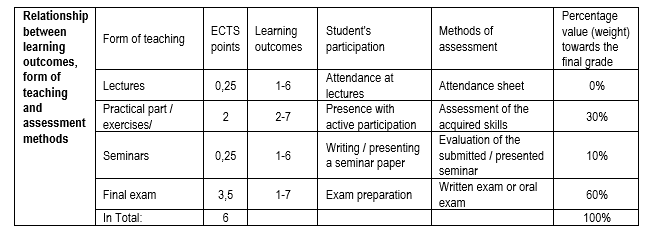Purpose of assessment in physical therapy. Outcome measures and theory of measurement; reliability, validity and objectivity. Subjective check-up, anamnesis, observation, palpation, measuring procedures and tests in physical therapy. Anthropometricmeasurements,measuring aerobiccapacity and endurance,assessment of joint integrity and mobility, measures for movement scale; measures of muscle strength - manual muscle test, dynamometry, testing of isometric and isokinetic muscle strength; posture assessment; pain assessment; skin integrity assessment, reflex activity assessment; assessment of activity in everyday life and of instrumental activity of everyday life; assessment of walking, locomotion and balance; ergonomic and biomechanical assessment; assessment of assistive and adaptive devises in use; specific physiotherapeutic methods and systems of assessment. Documenting and interpreting assessment results, and using them while planning physiotherapeutic intervention.
The course Anatomy will be observed from a functional viewpoint with special emphasis on clinical anatomy of adults. In clinically significant fields students have to know the anatomy of children, youth and pregnant women. Students have to be qualified to find and identify anatomic structures on the thorax, abdomen and extremities they will encounter in their clinical work every day. Furthermore, they have to recognise clinically significant differences that could affect the determination of clinical diagnoses and treatment. They have to recognise the mechanics of joint movement on the extremities and understand their significance during a clinical check-up.
Obavezna literatura:
- Filipović V, Klaić I, Jakuš L. Evaluacijska lista za procjenu terapijskih postupaka. Zagreb: Visoka zdravstvena škola; 1997.
- Mišigoj-Duraković M, Matković B, Medved R. Morfološka antropometrija u športu. Zagreb: Fakultet za fizičku kulturu Sveučilišta u Zagrebu; 1995.
- Jakuš L, Klaić I. Fizioterapijska procjena – nastavni tekstovi. Zagreb: Visoka zdravstvena škola; 2003.
Dopunska literatura:
- Hislop HJ, Montgomery J. Daniel's and Worthingham's Muscle Testing – Techniques of Manual Examination. Philadelphia, SAD: W. B. Saunders Company; 1995.
- Norkin CC, White DJ. Measurement of Joint Motion – A Guide to Goniometry. Philadelphia, SAD: F. A. Davis Company; 1995.
Upon completion of this course, students will be able to:
- Explain the importance of assessment as a basis for planning physiotherapy procedures
- Compare basic assessment methods in physiotherapy
- Use different systems of documenting and evaluating the obtained results
- Argue the conclusions of the assessment with arguments
- Present the basic practical skills of implementing subjective and objective assessment procedures in physiotherapy
- Create and lead physiotherapy interventions
- Actively participate in a comprehensive team assessment of users



